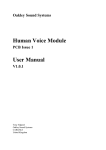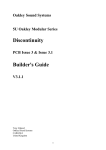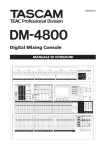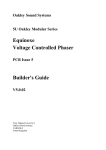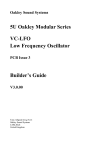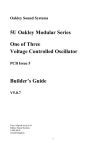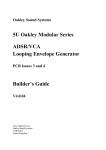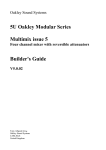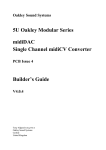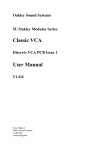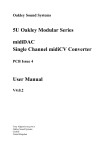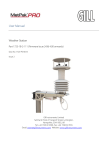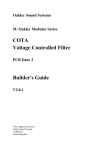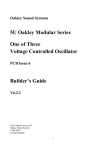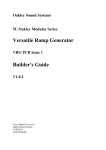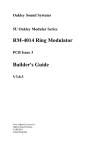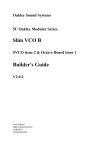Download VCO Controller Builder`s Guide
Transcript
Oakley Sound Systems 5U Oakley Modular Series VCO Controller 1U wide oscillator master module Builder's Guide V1.0.3 Tony Allgood Oakley Sound Systems CARLISLE United Kingdom Introduction This is the Project Builder's Guide for the issue 1 VCO Controller 5U module from Oakley Sound. This document contains a basic introduction to the board, a full parts list for the components needed to populate the board, interconnections and some basic testing methods. For the User Manual, which contains an overview of the operation of the unit, advice on connecting the unit and calibration procedures, please visit the main project webpage at: http://www.oakleysound.com/cv-cont.htm For general information regarding where to get parts and suggested part numbers please see our useful Parts Guide at the project webpage or http://www.oakleysound.com/parts.pdf. For general information on how to build our modules, including circuit board population, mounting front panel components and making up board interconnects please see our generic Construction Guide at the project webpage or http://www.oakleysound.com/construct.pdf. This is an early version of the documentation. If you do find any errors, even silly little ones, please do let me know either directly by e-mail or via the Forum or mailing list. 2 The VCO Controller PCB This is the prototype unit with natural finish Schaeffer panel. Note the use of the Sock8 board to mount the jack sockets. Two pot brackets are used to hold the PCB firmly to the front panel. The top pot does not have a bracket since this would add extra height to the board and foul the MOTM mounting rails. I have provided space for the three main control pots on the PCB. If you use the specified 16mm Alpha pots and matching brackets, the PCB can be held firmly to the panel without any additional mounting procedures. The pot spacing is 1.625” and is the same as the vertical spacing on the MOTM modular synthesiser and most of our other modules. The design requires plus and minus 15V supplies. The power supply should be adequately regulated. The current consumption is about 20mA for each rail. Power is routed onto the PCB by a four way 0.156” MTA156 type connector or the special five way Synthesizers.com MTA100 header. You could, of course, wire up the board by soldering on wires directly. The four pins are +15V, ground, earth/panel ground, -15V. The earth/panel connection allows you to connect the metal front panel to the power supply’s ground without it sharing the modules’ ground line. More about this later. The PCB has four mounting holes for M3 bolts, one near each corner. These are not required if you are using the two 16mm pot brackets. The board size is 107mm (high) x 110mm (deep). The board has been laid out to accept connection to our Sock8 socket board. This small board speeds up the wiring of the eight sockets and reduces the chances of mistakes. 3 Components For general information regarding where to get parts and suggested part numbers please see our useful Parts Guide at the project webpage or http://www.oakleysound.com/parts.pdf. Some special considerations for this project The op-amps used in this project fall into two distinct categories, low offset voltage bipolar and low input current FET types. U2, 3 and 4 should be high quality low offset low drift op-amps such as the OPA2277 or LT1013. These op-amps are used in the KCV pathway and should not contribute significantly to any errors. U1 and U7 should be FET types with low input bias current. The old stalwart the TL072 is perfectly good enough for this, although you could use the LF412. U8 could be any op-amp really, but the TL072 is cheap and good enough for this application. You will also need two single pole double throw switches. These are sometimes called SPDT or 1PCO (one pole changeover). They should be ON-OFF-ON types. This type of switch has one contact with a wiper that can move between two outer contacts and have a middle position that is touching neither outer contact. These switches have three solder tags and look identical to the more common ON-ON type. Watch out for sizes, there are many different types of toggle switches and some of them can be very big and will clash with the PCB if using the suggested panel design. I use miniature flat toggle types made by Apem and sold by Farnell. There are several 0.1% tolerance resistors used in this project. I strongly recommend that you use these and not 1% types in those locations. Failure to comply with this will mean that the octave switching between KCV1 and KCV2 will probably not track each other. The sockets may be fitted either directly to the panel and wired to the board using fly wires, or you can use our Sock8 socket board. This is available from us and facilitates easy connection from the sockets to the main board. If you are using the Sock8 board then it is recommended that you use 0.1” Molex KK or MTA100 headers and housings to interconnect between the two boards. 4 Parts List For general information regarding where to get parts and suggested part numbers please see our useful Parts Guide at the project webpage or http://www.oakleysound.com/parts.pdf. The components are grouped into values, the order of the component names is of no particular consequence. A quick note on European part descriptions. R is shorthand for ohm. K is shorthand for kiloohm. R is shorthand for ohm. So 22R is 22 ohm, 1K5 is 1,500 ohms or 1.5 kilohms. For capacitors: 1uF = one microfarad = 1000nF = one thousand nanofarad. To prevent loss of the small ‘.’ as the decimal point, a convention of inserting the unit in its place is used. eg. 4R7 is a 4.7 ohm, 4K7 is a 4700 ohm resistor, 6n8 is a 6.8 nF capacitor. Resistors All resistors should be 0.25W 1% metal film (MF) types unless stated. Some resistors are 'precision' 0.1% types and are marked accordingly. These should not be substituted with 1% MF. 75R 330R 390R 1K 2K2 4K7 6K8 8K2 10K 15K 19K6, 0.1% 20K, 0.1% 22K 39K 47K 51K 62K 82K 100K 100K, 0.1% 220K 330K 390K 470K 1M 3M3 R7, R12, R1 R50, R53 R35, R38 R51, R39, R43, R37 R27, R23, R52 R30 R29 R41 R15, R3, R2, R31, R19, R10 R47, R56, R45 R14, R8 R13, R17, R16, R9 R49 R20 R48, R26, R25 R21, R22 R36, R42 R46 R18, R28, R32, R24 R11, R6 R40, R34 R44 R54, R33 R5 R4 R55 5 Capacitors 33pF low-K or C0G ceramic 100pF low-K or C0G ceramic 22nF, 63V polyester film 100nF, 63V polyester film 100nF multilayer axial ceramic 2.2uF, 63V electrolytic C3, C2, C18 C17, C12 C11, C10 C1 C14, C13, C7, C15, C8, C16, C4, C6, C5, C9 C20, C19 Discrete Semiconductors BC560 PNP transistor 1N4148 silicon signal diode Q3 D1, D2 Integrated Circuits LM336Z-5.0 5V reference LM13700 Dual OTA LT1013CP TL072 U5 U6 U2, U3, U4 U7, U1, U8 Trimmers 22K horizontal 100K horizontal 10K cermet multiturn 1K cermet multiturn SHAPE SYM, OFFSET -OCT, +OCT SCL1, SCL2 Potentiometers 50K linear Alpha 16mm 50K log Alpha 16mm CV2/LFOMD, CV1/LFO LFO_RATE Two pot brackets are also required. LFO_RATE has no bracket. Miscellaneous Leaded Ferrite beads SPDT on-off-on switch Molex or MTA 4 way header MTA100 6-way header L1, L2 OCTAVE1, OCTAVE 2 PSU – Oakley/MOTM power supply PWR – Synthesizers.com power supply Molex/MTA 0.1” header 6-way Molex/MTA 0.1” header 8-way Molex/MTA 0.1” housing 6-way Molex/MTA 0.1” housing 8-way UPR – for connecting to sockets LWR – for connecting to sockets UPR – for connecting to sockets LWR – for connecting to sockets 1/4” sockets Eight off mounted either on the Sock8 board or on panel 6 You will also need solder, around 1m of 0.9mm solid core wire and around 2m of insulated multistrand hook up wire and a few cable ties. You may well want to use sockets for the ICs. I would recommend low profile turned pin types as these are the most reliable. You need six 8-pin DIL sockets and one 16-pin DIL socket. Additional components required if using optional Sock8 board Molex/MTA 0.1” header 6-way Molex/MTA 0.1” header 8-way Molex/MTA 0.1” housing 6-way Molex/MTA 0.1” housing 8-way UPR LWR UPR LWR 112APC Switchcraft 1/4” socket SK1, SK2, SK3, SK4, SK5, SK6, SK7, SK8 If using Molex KK you'll also need at least 28 crimp terminals. Suitable lengths of wire to make up the two interconnects and three cable ties. Additional components required if using the Oakley Buss Molex/MTA 0.1” housing 3-way 8 off If using Molex KK you'll also need at least 12 crimp terminals. Suitable lengths of wire to make up the interconnects. 7 Connections Power connections – MOTM and Oakley The PSU power socket is 0.156” Molex/MTA 4-way header. Friction lock types are recommended. This system is compatible with MOTM systems. Power Pin number +15V Module GND Earth/PAN -15V 1 2 3 4 Pin 1 on the LWR header has been provided to allow the ground tags of the jack sockets to be connected to the powers supply ground without using the module’s 0V supply. Earth loops cannot occur through patch leads this way, although screening is maintained. Of course, this can only work if all your modules follow this principle. Power connections – Synthesizers.com The PWR power socket is to be fitted if you are using the module with a Synthesizers.com system. In this case you should not fit the PSU header. The PWR header is a six way 0.1” MTA, but with the pin that is in location 2 removed. In this way location 3 is actually pin 2 on my schematic, location 4 is actually pin 5 and so on. Power Location number Schematic Pin number +15V Missing Pin +5V Module GND -15V Not connected 1 2 3 4 5 6 1 2 3 4 5 +5V is not used on this module, so location 3 (pin 2) is not actually connected to anything on the PCB. If fitting the PWR header, you will also need to link out LK. This connects the panel ground with the module ground. Simply solder a solid wire hoop to join the two pads of LK together. Using the Sock8 board This is the simplest way of connecting all the sockets to the main board. The Sock8 board should be populated in the way described in our construction guide found on the project webpage. There are only two headers, UPR (for upper) which is six way, and LWR (for lower) which is eight way. Both headers are fitted to the bottom side of the board. 8 You need to make up two interconnects. The six way one should be made so that it is 90mm long. The eight way should be made to be 140mm. The prototype unit showing the detail of the board to board interconnects. Here I have used the Molex KK 0.1” system. Module to Module Interconnects using the Oakley Buss The standard build of the VCO Controller makes use of normalised connections to the other modules in your modular synthesiser. Some further details of these are covered in the User Manual. The Oakley Buss conforms to a simple three way 0.1” Molex KK header, although you could use a MTA100 header instead. Pin 1 is keyboard control voltage KCV at a sensitivity of 1.000V/octave Pin 2 is not normally used and is taken to ground on the Dizzy board. Pin 3 is gate where a active note generates +5V, and an inactive note is 0V. The VCO Controller does not use the gate signal but the two headers marked BUSS1 and BUSS2 are connected so that gate and KCV signals are passed through. 9 Each Oakley Buss header on the board is therefore a three way device, but note that not all three wires need to be connected to make it work properly. CV1 is the header that sends KCV1 to your first VCO, or your bank of VCOs that you want to control with the top octave switch. The Oakley VCO features a three way header on the socket board. Simply connect the CV1 header to the this header and the VCO Controller will now connect to the VCO. Only pin 1 need to be connected though. There is no need to wire in all three wires to each housing. If your VCOs do not have an Oakley Buss fitted, ie. Older issue 1, 2 and 3 boards, then you need to make what I call a CV tail. You may have already done this if you used the Oakley Buss on the Dizzy. If not making a tail is easy. Simply solder a suitably long wire onto the NC lug of the 1V/octave input socket of the VCO. Attach it to a three way Molex or MTA housing at location pin 1. If your VCO module has the NC connected to ground then remove this before soldering on your tail. CV2 is the header that sends KCV2 to your second VCO or your bank of VCOs that you want to control with the bottom octave switch. Connect this as you have done with the CV1 header. The Oakley midiDAC-3 already has a Oakley Buss header fitted. Simply make up a interconnect that joins the midiDAC with the VCO Controller at BUSS1. You only need two wires in your interconnect, there is no need to join the two pin 2s together, as we only want KCV and gate to go to the VCO Controller. If you have an older issue 2 or issue 1 midiDAC you will have to make some tails from the midiDAC's output sockets if you want normalisation. You can, of course, simply use a patch lead to connect the VCO Controller's KEY-CV socket to the midiDAC's KEY-CV socket. BUSS2 can be connected to your modular's Dizzy board via another interconnect. Again use a two wire interconnect as you probably want both KCV and gate to be present on your Dizzy. Alternatively, if the Dizzy is already carrying KCV and gate from the midiDAC you may simply use a single wired interconnect (pin 1 to pin1) to take KCV to the VCO Controller from the Dizzy. You need not use BUSS2 in this case. The only issue with this is that KCV has had to go through two sets of interconnects between the midiDAC and the VCO Controller. The KCV signal is prone to some interference from noise and poor contacts. It is therefore best to minimise the amount of interconnects it does have to travel through. Wiring the midiDAC direct to the VCO Controller does minimise the risk somewhat particularly as it is expected that the VCO Controller is situated next to the midiDAC. Wiring the sockets without using a Sock8 The Sock8 was specifically designed to be used with the standard front panel layout which in turn relies heavily on the use of the internal Oakley Buss. However, you may wish to utilise different input and output combinations and hand wiring them to the main board may therefore be more suitable. Page 2 of the schematics show the full input and output sections of the module. There are six 0.1” headers on the board. Pin 1 is the square pad. 10 BUSS1 Pin 1 goes to pin 1 of BUSS2 and to pin 5 of UPR Pin 2 goes to pin 2 of BUSS2 Pin 3 goes to pin 3 of BUSS3 CV1 Pin 1 CV1 output to VCO1 - the KCV output controlled by the top octave switch Pin 2 not connected Pin 3 not connected CV2 Pin 1 CV2 output to VCO2 - the KCV output controlled by the bottom octave switch Pin 2 not connected Pin 3 not connected UPR Pin 1 Pin 2 Pin 3 Pin 4 Pin 5 Pin 6 VCA CV output not connected module ground VCA CV input Key CV from buss Key CV input - this is the low pass filtered output from VCA CV input - joined on the PCB to pin 2 of the PSU/PWR connector - this is the control voltage for the internal VCA - joined on the PCB to pin 1 of BUSS1 and BUSS2 - the master KCV input to the module NB Pins 3 and 5 go to the NC lugs of the VCA CV IN and KEY-CV sockets respectively. LWR Pin 1 Pin 2 Pin 3 Pin 4 Pin 5 Pin 6 Pin 7 Pin 8 Panel ground Square wave out VCA out Sine wave out Sine wave out 2 CV in Sine wave out 2 VCA in - connects to pin 3 of the PSU connector - LFO output - Output of internal VCA - Output of sine shaper circuit - Another output of sine shaper circuit. - CV input – goes to the CV/LFO depth pot - Copy of pin 5 - Audio/CV input to VCA NB Pins 5 and 7 go to the NC lugs of the CV IN and VCA IN sockets respectively. 11 Testing, testing, 1, 2, 3... Apply power to the unit making sure you are applying the power correctly. Check that no device is running hot. Any sign of smoke or strange smells turn off the power immediately and recheck the polarity of the power supply, and the direction of the ICs in their sockets and the polarity of the electrolytic capacitors. Now if you have not done so already it is time to plug the unit into your modular. You will have several interconnects to fit before you can use the VCO Controller. Set up a standard synthesiser patch of keyboard interface (midiDAC), two VCOs, a VCF, VCA and an ADSR to gate the VCA. Set all the pots on the VCO Controller to their minimum settings. Now play a few notes on your keyboard. You may notice that the pitch goes slightly out of tune as you work your way up the keyboard. This is fine, you'll be calibrating the scale later. Make sure that both octave switches change the pitch of the connected VCOs. Again, you will not have a perfect octave shift but it should be fairly close. Now turn the LFO/CV vibrato depth pot up. You should notice that both VCOs will start to change pitch with the actions of the module's internal sine wave LFO. Check that the depth of the effect gets greater the more the pot is turned up. Now change the LFO rate pot. Check that the LFO frequency goes up as the pot is turned up. It should go to very slow to around 50Hz at its fastest. Turn up the VCA Vibrato Depth. Hopefully, this should not do anything yet. If it does you may have a problem with the VCA part of the circuitry. Insert a patch lead from the ADSR or another LFO output into the CV IN socket. Check that the VCO Controller's internal LFO is disconnected and that the inserted modulation source is now controlling both VCOs instead. The LFO/CV Vibrato depth pot should still control the depth of the modulation. Turn this pot to its lowest setting ready for the next test. Remove the patch lead from the external modulation source. Connect the patch lead from the aftertouch or modulation wheel CV output of the midi-CV convertor (or any other variable CV source) to the VCA CV IN socket. Now turn up the VCA Vibrato Depth pot again. You should find that as the applied CV goes up the internal LFO is once again modulating both VCOs. The overall depth of the modulation is therefore controlled by both the depth pot and the externally applied CV. With no aftertouch or mod wheel CV applied there should be no LFO modulation heard. Turn down the vibrato depth pot and connect another patch lead from the VCA CV OUT socket to a cut off CV input on your filter. You should find that as the aftertouch or mod wheel is applied then the filter's cut-off frequency rises. It should be smooth and not lumpy like it normally is with CC information. Check now that you have a rough sine wave output from the SINE OUT socket, and a square wave output from the SQR OUT socket. You can modulate the cut-off frequency of the connected VCF to hear the LFO's affects. The sine wave should cause the cut off frequency to rise and fall smoothly, while the square wave will cause abrupt changes between two values. 12 Lastly, you need to check the operation of the VCA IN socket. Chances are that it will work just fine because the CV control of LFO depth would not have worked otherwise, but let's give it a go. Remove the audio output from your VCOs to the VCF. Put one of the VCO outputs into the VCA IN of the VCO Controller module. Now connect the VCA OUT to the input of the filter. You should find that the aftertouch or mod wheel now controls the volume of the VCO being sent to the filter. If all this happens, the chances are that you have a working module. Now before you start to use it in your modular you will need to calibrate it. The full calibration procedure can be found in the User Manual. 13 Final Comments If you have any problems with the module, an excellent source of support is the Oakley Sound Forum at Muffwiggler.com. Paul Darlow and I are on this group, as well as many other users and builders of Oakley modules. If you can't get your project to work, then Oakley Sound Systems are able to offer a 'get you working' service. If you wish to take up this service please e-mail me, Tony Allgood, at my contact e-mail address found on the website. I can service either fully populated PCBs or whole modules. You will be charged for all postage costs, any parts used and my time at 25GBP per hour. Most faults can be found and fixed within one hour, and I normally return modules within a week. The minimum charge is 25GBP plus return postage costs. If you have a comment about this builder's guide, or have a found a mistake in it, then please do let me know. But please do not contact me or Paul Darlow directly with questions about sourcing components or general fault finding. Honestly, we would love to help but we do not have the time to help everyone individually by e-mail. Last but not least, can I say a big thank you to all of you who helped and inspired me. Thanks especially to all those nice people on the Synth-diy and Analogue Heaven mailing lists and those at Muffwiggler.com. Tony Allgood at Oakley Sound Cumbria, UK © February 2010 – updated May 2013 No part of this document may be copied by whatever means without my permission. 14















